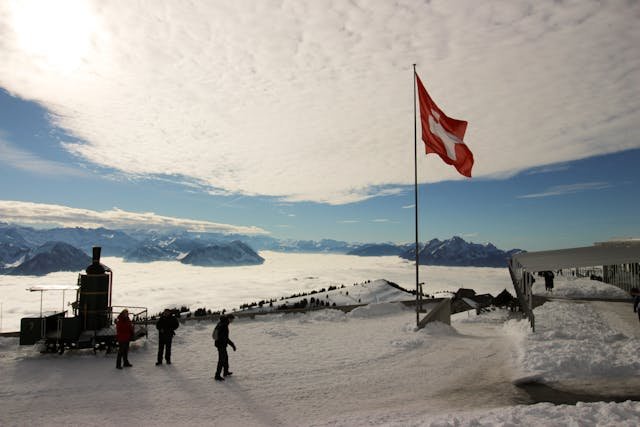Physical Address
304 North Cardinal St.
Dorchester Center, MA 02124
Physical Address
304 North Cardinal St.
Dorchester Center, MA 02124

Switzerland is famous for its high quality of life, well-developed infrastructure, and commitment to environmental sustainability.
The key to Switzerland’s success and social harmony lies in its rich diversity, attributed to the country’s four official languages. The question is; what languages are spoken in Switzerland?
Unlike other multilingual communities, Switzerland successfully avoids common social tensions. The Swiss people’s ability to speak four official languages serves as a major strength.
Although these languages are spoken throughout the country, they are predominantly concentrated in specific regions. This linguistic diversity contributes to Switzerland’s unique cultural mosaic, fostering a sense of unity and understanding among its people.
The Swiss embrace their multilingualism, creating a harmonious environment where different linguistic communities coexist peacefully. This inclusive approach not only enhances social cohesion but also reflects the country’s commitment to embracing diversity as a fundamental aspect of its identity.

Swiss German is the most commonly spoken language in Switzerland. About 60% of people speak it, especially in the north, centre, and east of the country. Locals call it Schwyzerdütsch, and it’s made up of Alemannic dialects not used anymore in Germany or Austria.
Swiss kids learn Standard German in school, so they can talk easily with Germans, Austrians, and other German speakers. They switch to Standard German easily when talking with someone who doesn’t speak Swiss German.
Since not all Swiss German dialects have a standard written form, laws, books, and newspapers are written in Standard German. That’s why most Swiss Germans call it Schriftdeutsch, which means “written German.”
Swiss German isn’t just one dialect— it varies a lot depending on where you are. For example, the dialect in Zurich is different from Basel, and it’s even more different in an Alpine village.
Formal situations usually use Standard German, especially if there are non-Swiss German speakers around. But in private and among Swiss Germans, dialects are the norm.
French is the dominant language in the western part of the country, a region known as Swiss French.
According to Wikipedia, about 22% of the Swiss population speaks French, making it a significant linguistic influence in cities like Geneva and Lausanne. If you’re planning a trip to these Swiss destinations, having a French dictionary could be handy, as they are primarily French-speaking areas.
Compared to the distinctions between Swiss German and Standard German, the variations between Swiss French and the French spoken in France are less pronounced. Although there are some differences in vocabulary and expressions, individuals who are proficient in Standard French should find it relatively easy to pick up Swiss French.
The prevalence of French in Swiss cities creates a distinct linguistic environment, making it beneficial for travellers to have some knowledge of the language. Whether you’re exploring the cultural richness of Geneva or enjoying the scenic beauty of Lausanne, having a basic understanding of French can enhance your experience and interactions with locals.
Also Read: Most Important Languages To Learn For More Opportunities
Swiss Italians reside in the southern part of Switzerland, near the border with Italy. With a population of 673,000 speakers, they constitute almost 8% of the country’s population.
For anyone familiar with Italian or learning the language, Swiss Italian is relatively easy to comprehend, similar to Swiss French. The main distinction lies in a few significant loanwords from German and French.
Despite the existence of local dialects such as Ticinese and other Lombard-influenced variations, Swiss Italian closely resembles Standard Italian in Switzerland.
In contrast to Standard Italian, Swiss Italian stands out for its use of “calques,” phrases that seem like literal translations from French and German.
For instance, while the Italian term for “driver’s license” is “Patente,” Swiss Italians use “Licenza di condurre,” a direct translation from the French term “permis de conduire.” Despite these linguistic nuances, the overall communication between Swiss Italians and speakers of Standard Italian remains quite smooth.
Romansh is a small language spoken by only 37,000 people. It became a national language in Switzerland in 1938, but it wasn’t until 1996 that it gained official recognition.
In the southeastern canton of Grisons, Romansh is an official language used in governance and education, as well as in everyday communication within the community.
Despite facing competition from Italian and German, Romansh has survived into the 21st century. This is partly because most Romansh speakers come from isolated, mountainous regions in southeast Switzerland.
The influence of the German language on Romansh is significant. Despite its small speaker base, Romansh has five dialects that are used in daily life. Efforts by the government to promote a unified “pan-Romansh” have had mixed results at the local level.
Switzerland emphasizes the importance of adopting the national language for integration. However, a significant number of immigrants in the country still prefer communicating in their native languages.
According to the Swiss Federal Statistical Office, commonly spoken languages in the country include English, Portuguese, Albanian, etc.
A notable percentage of the population in Switzerland primarily communicates in languages other than the national ones. About 5.8% of the population speaks English, 3.5% speaks Portuguese, 3.2% communicate in Albanian, 2.3% in Serbo Croatian, and 2.4% in Spanish. Additionally, there is an 8.2% portion that uses languages falling under the category of “Other.”
The linguistic diversity in Switzerland highlights the coexistence of various languages within its borders. Despite the emphasis on the national language for nationalization, the presence of multiple languages reflects the rich cultural tapestry shaped by the country’s diverse immigrant population. The statistics underscore the ongoing importance of recognizing and accommodating linguistic diversity in Switzerland.
Also Read: What Is Cultural Assimilation?
Four different official languages are spoken in Switzerland. Here are some simple greetings you can use:
Hello:
Goodbye:
Please:
Thank you: